I’m sharing my story on why I stopped feeding my dog kibble, the alternatives and their pros and cons.
I stopped feeding my dog kibble and never going back. I am strictly going to mention commercial and semi-commercial dog food in this post, which means I am not talking about feeding home-based raw or any completely DIY dog food recipes. The main point of this post is about commercial dog food alternatives to kibble, and their pros and cons.
Buckle up, because it’s a long one!
The 6 dog food alternatives I unpack in this post:
You might be asking, “And what do you know?“, right? What do I know? For context, I quit feeding my dog kibble back in 2018. I won’t be that person to sit here and bash kibble (when there are some I could recommend), but my boy was beginning to deal with some pretty gnarly health issues (dental, gut, skin, joint, muscular and heart-related) and he was getting to an age where I just felt like I could do more and better for him (all around).
Kibble these days contain a bunch of filler, like starches, sugar, legumes, carbohydrates and by-products (to name just a few). Kibble also has zero moisture content, which we expect them to eat dry on a daily basis, and the high-heat processing of kibble essentially destroys all flavor, to which natural and artificial flavoring is necessary to appeal to any creature (this doesn’t even include the nutrients from the food itself). Does kibble ever actually smell good, or like food?
Plus, it didn’t help that my dog was on the chubbier side since he was about 4 years old, despite not over-eating. When I fed him kibble, he often acted like I was depriving him when not long after he would be begging to eat again.
Ok, ok, ok, it was the treats. I mean, that face, can you blame me? This is Andrea, and I will be referring to his name from now on.

Anyway, at the same time Andrea had also been dealing with severe, unresolved skin issues since the age of 2, and I finally came around to getting him an allergy test. The results indicated he was allergic to many of the common ingredients found in commercial dog kibble, like beets or beet pulp, pork, barley, potatoes, rice and apples.
I knew it was likely impossible to rid of all the things he was allergic to, but I wanted to try my best. In the midst of Andrea’s journey, after months of research, I decided it was time to give the commercial raw diet a go. Best of all, it was approved by my dog’s Cardiologist (being he has a degenerative heart condition and was advised against *grain-free* food at the time).
And that’s what I want to touch on next, since many in question might chomp at the bit to caution dog foods that are considered or labeled grain free. The grain free trend was a boutique thing being that most boutiques recommended *premium*, or gold standard pet diets. Brands like Fromm and Acana come to mind.
The foods were glorified for having no corn, wheat, soy and grains, and they cost a premium more, too. Instead, though, what they don’t mention is that in place of those grains, diets were introduced with a variety of legumes and other starchy carbohydrates such as peas, chickpeas, lentils and potatoes. And, unfortunately, oftentimes those ingredients superseded meat protein – you’d find them within the first five or so listed ingredients on the bag.
Many diets, specifically for food allergies, even went the route of vegetarian based. We even have vegan diets for dogs now, but I won’t even go there. As you can imagine, those diets eliminate most or all meat proteins as primary ingredients and then are substituted for legumes (among other fillers).
So when I presented these to Andrea’s cardiologist as the very ingredients I should avoid, he nodded in approval when I presented the commercial raw diet that I proposed feeding him since it contained none of those ingredients (no legumes) and yet is considered a grain-free option.
That is all I will say in regard to the grain-free deboggle, and, no, I am not an expert. I simply discussed with, took the advice of, and received approval from Andrea’s specialist and holistic vet.
6 Commercial dog food alternatives to kibble, and what I honestly have to say about them
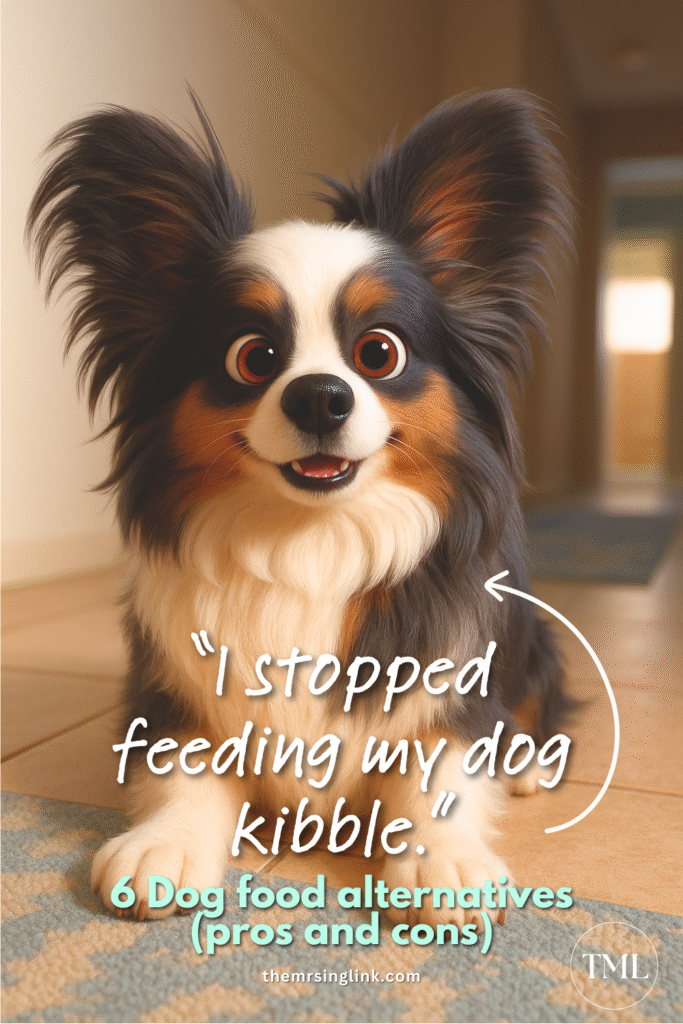
Making the switch from commercial kibble used to be insanely taboo, but now that there are many varieties being recognized and even formulated by Veterinarians (don’t worry, I’ll fill you in), it’s really not as scary or frowned upon as others make it seem.
I think it’s the most unfortunate that many run-of-the-mill veterinarians are simply not willing to get on board with the fact that a quality diet matters, let alone acknowledge that they’re not even canine nutritionists. A dog’s diet is a greater piece of the overall health pie long-term than they care to admit – the same is for humans.
That being said, I’m unpacking the alternatives, discussing their pros and cons and suggesting options for each. *Please note that I only have real, personal experience with giving my dog the dehydrated, frozen raw, freeze-dried raw and semi-commercial base mix alternatives at this time.
This post contains affiliate links. All products and links listed on TML are affiliates through 3rd parties such as Awin, Etsy and Amazon. Meaning, at no cost to you, by clicking and purchasing through those links I will earn a small commission. As an Amazon Associate, I earn from qualifying purchases. To learn more read TML Terms and Disclosure.
Dehydrated
As far as dehydrated dog food goes, I can only attest to two brands in particular that are actually labeled as being dehydrated, but I will only be mentioning one since the other is better suited to be discussed in another alternative.
Dehydration means the food undergoes a gentle heating process to remove moisture. I had a dehydrator for a short time – I made dried fruit with it. It’s a lengthy process because it takes quite some time to remove moisture with low heat.
Though this food is not exactly considered *cooked*, the dehydrating process can kill and inhibit harmful bacteria if performed correctly, so that’s pretty reassuring for those who worry about food safety.
When I decided to make Andrea’s very first switch from kibble, the dehydrated diet was first on my list to try, and the most obvious brand at the time was The Honest Kitchen (THK). Since that is the only dehydrated brand of completely balanced dog food I am currently aware of and tried for an extended period (roughly a year or two), I have nothing else to compare.
Pros
Right off the bat, Andrea loved the food since he had been accustomed to dry kibble from a puppy. The dehydrated food is designed to be rehydrated before feeding, which makes it super easy to prepare and store in the fridge. I could make several days’ worth of food ahead of time and take out what I needed for each meal.
Otherwise, storing the dehydrated food is treated the same as you would kibble – preferably in an airtight container in a cool, dark place.
In addition, since I’m speaking about THK, their food is rated as human grade, which is reassuring. And there are a few different recipes to choose from that vary in protein sources and other main ingredients you wouldn’t normally find in kibble, such as turnips, bananas, kale and celery. They also have whole grain varieties as well as your grain free options. I obviously went with the whole grain recipes being that I was against legumes.
Cons
Forewarning that when I mention the cons, they are primarily based on my individual (or, Andrea’s, rather) experience.
There wasn’t necessarily anything wrong with THK itself, but after some time I started to notice two things: Andrea began pooping A LLLLLOT more (upwards of 5-7x a day), as well as having continuous bouts of acid reflux. And these things didn’t subside after the adjustment period or with changing recipes.
Also, since Andrea was dealing with skin and food allergies, THK recipes typically contained numerous ingredients he was allergic to or closely allergic to. Unfortunately, I introduced him to the food prior to getting his allergy test done, so it didn’t seem worth keeping him on a diet if his itching wasn’t alleviated or made worse. But it is worth noting that other dog owners of allergy sufferers, per reading reviews, had positive results from using THK.
My only con with the dehydrated food, from using the THK, was that their ground recipes are typically a “mush” when rehydrated and aren’t the most appealing (which may be a problem for picky eaters). In Andrea’s case, since he loved the food, he would eat very fast, despite using a slow feeder bowl.
Yet, at the same time, I only started using THK before the brand came up with another food type called Whole Food Clusters, which is their version of a dehydrated kibble. This could be a great kibble substitute that is still technically dehydrated fresh food.
Frozen raw
I made the switch to frozen raw commercial dog food after receiving approval from Andrea’s Cardiologist, because it was around the same time he had just been diagnosed with Mitral Valve Degenerative Disease. It was after much discussion, debate and research I decided the pros outweighed the cons and chose to go with Primal Raw.
Many people shy away from raw food in general for understandable reasons – cleanliness and bacterial/salmonella risks. I get it, I do, yet I knew the risks and decided it was worth trying. And, needless to say, overall, I’m glad I did.
Pros
First, again, Andrea loved the food. I did anticipate commercial raw to look more like a mush, being that was a complaint of mine in the previous point. Commercial raw typically comes in either small nuggets or large patties. For the nuggets, it was easy to transfer however many Andrea needed (the number of nuggets based on his weight) in a container for the next day and allow to thaw in the fridge overnight.
After some time, the first thing I noticed was his pooping frequency and heftiness had dropped significantly. At first, I was a bit concerned, because he went from having such large bowel movements and going so often to almost the opposite. I was reassured after enough digging through raw diet forums and communities that it was related to not only improved absorption but also digestion.
In addition, over time his skin also improved dramatically. It could also be that I had started Andrea on immunotherapy injections, but either way a win is a win in my book.
Overall, since Andrea was on commercial frozen raw for the greater portion of his senior years (from the age of 9 to 13), he still acted and appeared like a puppy despite the natural signs for his age. And that’s a pro for me.
Cons
Obviously, the handling factor and potential risks of dealing with raw food can always be a discouragement, but for me the pros and benefits outweigh the cons I’m about to list. This is subjective per individual.
The frozen raw food has its limitations and inconveniences. For one thing, the price can be pretty steep for medium and large sized dogs. With Andrea, I was typically buying a bag per week, at roughly $20-23/bag. So, nearly $100/month on food for a 16 pound dog.
If you need to feed your dog on the go (i.e., in the car) the food must be kept refrigerated. BUT, there is a solution for this in my next alternative, which means you wouldn’t need to give up raw in this case.
Also, since your dog is eating raw food, there’s always the glum factor of having to avoid kissing your dog’s face or allowing your dog to lick you (which, I guess is something you probably aren’t supposed to do, regardless) in the case of cross-contamination.
Annnnd what ultimately lead up to removing Andrea from frozen raw food was when he developed an unexpected and repetitive infection in one of his salivary glands, where the opening was apparently much smaller than the others.
At that point, his dental specialist heavily advised against continuing him on raw food, and it was best to move onto the next phase of his diet journey at 13 years of age.
*Just FYI, Andrea’s situation does not shy me away from the commercial raw diet. I don’t believe this to be a *told you so*, but rather I see his unfortunate situation as being a one-off situation.
Freeze-dried raw
Commercial frozen raw and freeze-dried raw are essentially the same in that they’re both raw, but the processing is different. Freeze-dried raw food goes through a process called sublimation, where essentially the moisture is removed at very low pressure while still locking in nutrients and flavor.
The freeze-drying process does not kill illness-causing bacteria, salmonella and viruses, nor does it *cook* the food, though is does slow down or inhibit their growth by removing the moisture. This makes freeze-dried raw dog food more shelf stable.
I wanted to make sure I got those factoids out of the way before I carry on.
During the time I was feeding Andrea frozen raw, I had also implemented freeze-dried sporadically as well. I had made the full switch to freeze-dried for a very short period while figuring out the situation with his salivary gland, but once I decided to stop feeding him raw altogether, that also included the freeze-dried.
Again, Andrea’s situation doesn’t change how I feel about the raw diet since I believe his situation was a happenstance.
Pros
Being that the freeze-dried has a stabler shelf life, it can be stored much longer as long as it’s kept away from moisture. So taking this food with me on the go was possible whereas the frozen I needed to keep cold.
The food itself doesn’t need thawing, which makes serving time faster since all you do is add water to moisten it (though, I’ll be honest, there’s a bit more to it than that with certain brands). Primal and Stella and Chewy’s freeze-dried raw comes in nugget, disc, and now even kibble *bite-sized* form.
Other brands, like Dr. Marty’s (a veterinarian-derived formula) freeze-dried raw comes in little pellets (pictured below). I had only discovered Dr. Marty’s at the very end of Andrea’s raw food journey, but it was 10/10 in my book and would continue him on that food if I could.
Oh, and the last pro is that Andrea scarfed down these foods like I had been starving him for ages.
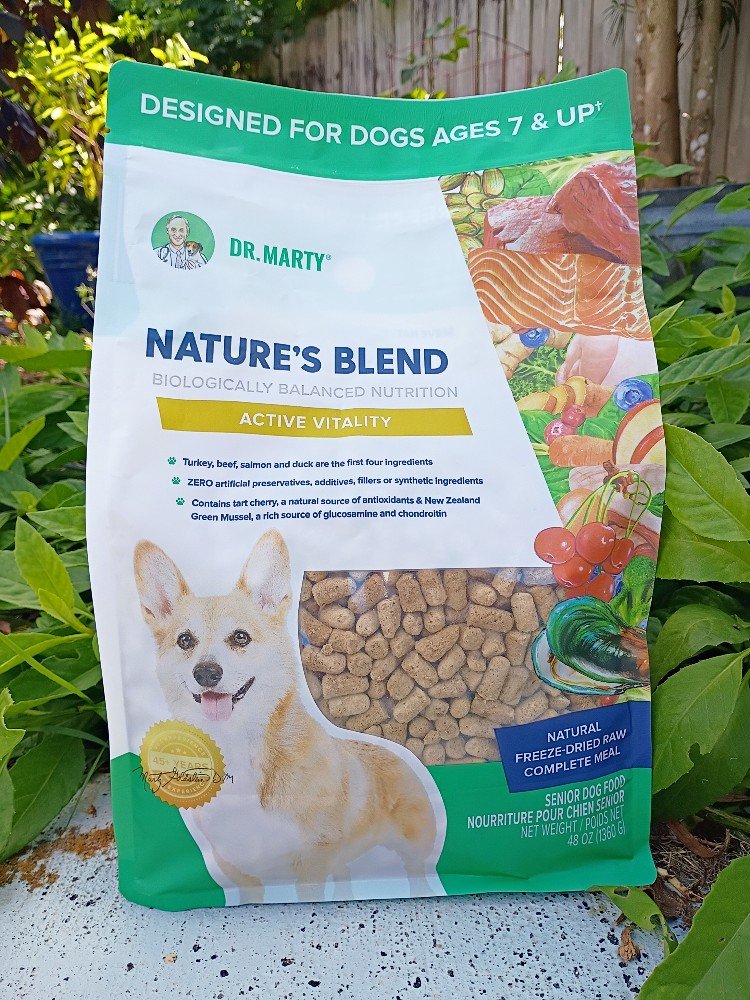
Cons
Again, each freeze-dried brand is going to be a little different, but the only brands I am familiar with using are Primal, Stella and Chewy’s, and Dr. Marty’s. So there are likely many other varieties out there that don’t fit the mold of my cons here.
Particularly with Primal and Stella and Chewy’s freeze-dried nuggets and patties, there’s definitely an inconvenient handling factor because the food requires breaking apart with your hands before adding water.
I can’t imagine anyone would just let their pet eat the nuggets or discs whole, let alone dry – to me, that’s such a choking hazard. Anyway, and some of the proteins were harder to break than others, which can be annoying when you’re feeding multiple times a day.
Also, the food can actually be rather messy being freeze-dried. There’s a dust and crumb factor to deal with despite how convenient the food is shelf-wise. This may be a deal breaker in that sense. But luckily it seems like more commercial raw brands are getting on board with creating kibble-sized food for easier feeding, such as Primal’s In The Raw Scoop and Feed freeze-dried raw diet.
And lastly, another downside is that the freeze-dried is a premium price compared to frozen raw simply because of the processing and shelf life. So when my weekly bag of frozen was roughly $20-23 per bag, a bag of freeze-dried was usually $10-15 more.
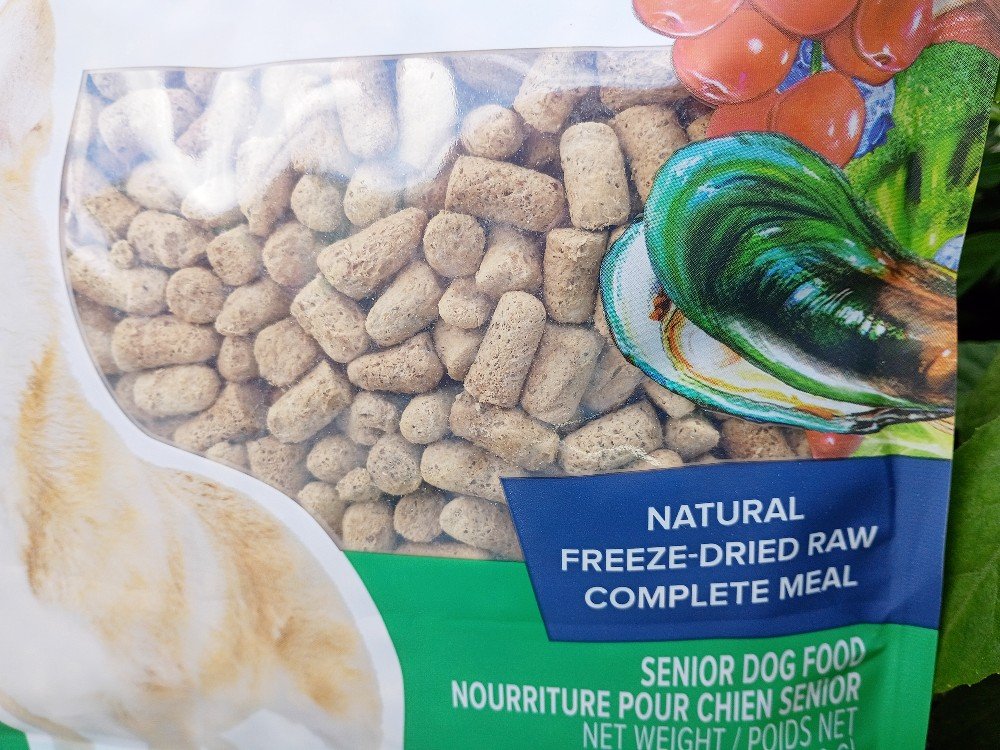
Base mix (semi-commercial)
Since Andrea’s salivary infection fiasco, I settled upon what I’d consider a happy medium. As of almost a year in, he’s loving it and there are no issues! Introducing the base mix, semi-commercial dog food alternative option!
Personally, I think it’s the best of both worlds because all I need to worry about is gently cooking the protein of my choosing and simply rehydrating the base mix in my half of the equation.
That’s why I call it semi-commercial, because Dr. Harvey’s (another veterinarian-derived formula) takes care of the rest with his dehydrated base mixes. Plus, he has several base varieties I can switch around to vary up the different ingredients in Andrea’s diet, along with varying his protein source (which is up to me to get from the store).
See, that’s why I didn’t mention this one in the dehydrated food section.
There are, so far in my research, limited brands who do base mix options, like Dr. Harvey’s, Sojos Mix-a-Meal, Grandma Lucy’s, and Canine Caviar. The Honest Kitchen even has a base mix option as well.
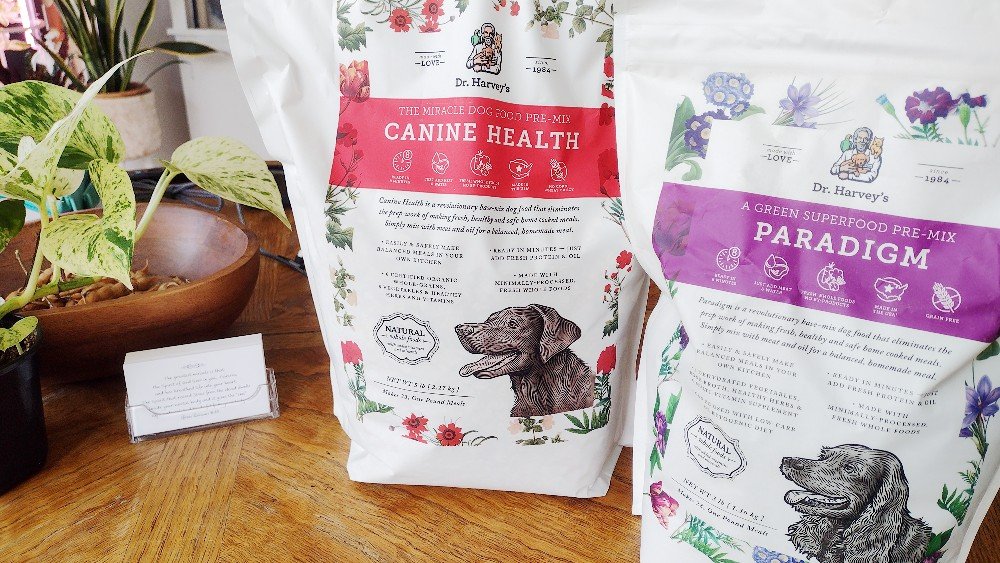
Pros
While prep is a tad bit more work than I’d say any of the other alternatives in this post, since I have to cook the protein, I’d say this diet is far more versatile since I get to control the amount and type of protein.
In addition, these base mixes are considered a complete diet, which I know is what many dog owners worry about when feeding anything other than kibble. Yet, at the end of the day, even with kibble, nothing is perfect. For example, dogs on kibble may still need higher or lower protein, lower fat content, extra omegas, a joint supplement or things like fiber, especially at different phases of their life.
Another pro is that the base mixes I’ve either used or researched are made with whole foods – meaning, there’s very limited processing involved. For instance, in Dr. Harvey’s, I can literally see almost every ingredient listed in the food. And, it smells like real food, you know?
Here’s a picture of one of Andrea’s typical meals using Dr. Harvey’s base mix plus added cooked protein – this one features ground Turkey!
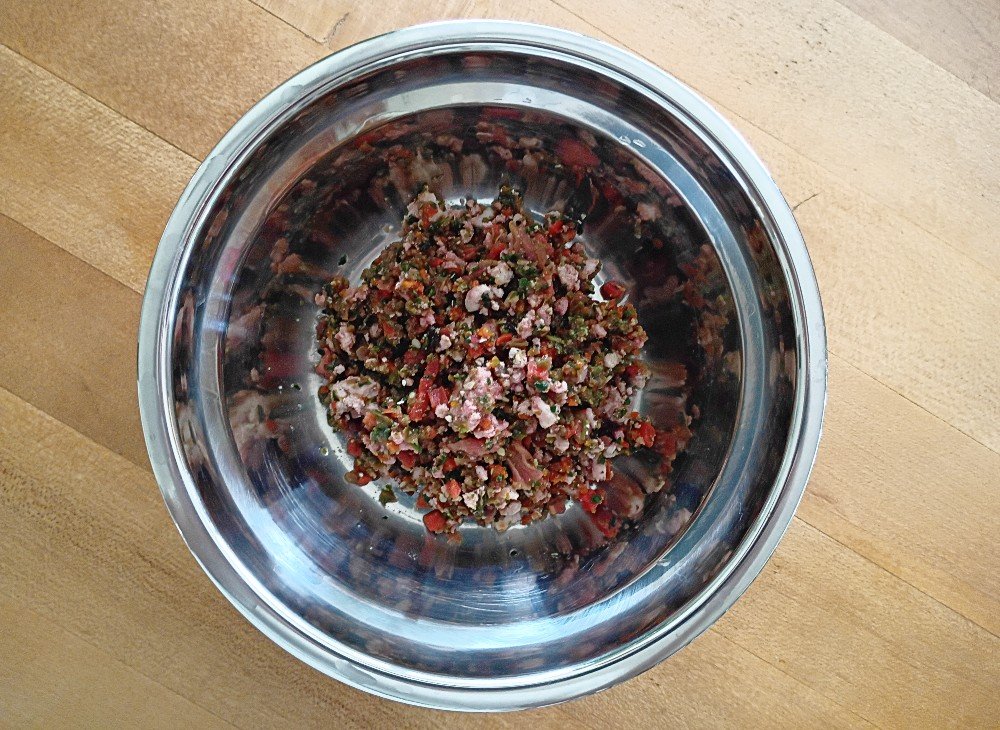
My main pro for this alternative is semi-feeling like I’m providing a home-cooked meal, even if it isn’t fully. The cooked protein and the base mix actually looks homemade because you can literally make out almost every ingredient on the bag.
Oh, and – shocker – Andrea loooooves it, especially when I surprise him with a specialty protein now and then, like rabbit or kangaroo.
Cons
Having to do any prep work beyond the minimal might be a complete turn off for those who don’t want to have to outsource the protein, let alone cook it. There is a bit more of that for me, but this is a con I am willing to look over. Andrea’s almost 14, so I’m committed at this point in his life.
Similar to the frozen raw diet, convenience for travel isn’t the best. While base mixes themselves are typically dehydrated, have a shelf life and only need water added to make it serve-ready, there’s still the protein factor missing. So when I travel, I have to prep this food ahead of time and have to have a way to keep it cool. This factor can also be a letdown for some.
Moreover, this diet route may not be the cheapest route. In the long run, compared to the others, I spent just about the same as I would on the raw diet, but it can seem like I spend more just because I am buying protein more often (weekly). At the end of the day – er, month – I’m probably spending closer between $100-$125 to maintain my dog on this diet.
So for someone with a much larger companion, price can seem daunting. The Dr. Harvey’s product feeding and cost calculator on their product page will tell you how long a bag would last and how much it would cost your dog per day (with added protein) to give dog owners an idea of the cost breakdown.
Air-dried
Just for FYI, the next two alternatives Andrea has never had, and I don’t have plans to change to in the near future. This means my opinion is strictly based on research, not personal experience.
Air-dried, similar to dehydrated, is the process of slowly removing moisture at low temperatures in order to preserve flavor and nutrients while making the food shelf stable.
I find that air-dried is less common and a bit newer in the dog food realm. Brands like ZEAL PET, Ziwi Peak, and Sundays for Dogs are just a few gently air-dried dog food alternatives I’ve encountered, but it seems to be a diet growing in popularity. Even some of your known kibble brands are getting on board with going air-dried, like Wellness Core.
Pros
Shelf life and convenience are two major pros for the air-dried diet, which makes it perfect for those who want minimal guesswork, prep and the convenience of taking food on the go. Simply scoop and feed.
The air-dried recipes I looked into really seemed to focus on using whole foods without a ton of filler or legumes. There also seems to be a wider variety of protein options, which is helpful for allergy sufferers, and the implementation of organ meats and omegas for added nutritional benefit.
I’m noticing the food typically resembles a bit like jerky in bites or pieces. Some seem harder or more pliable than others, so it sounds like a promising alternative for those who anticipate a food their dog to not only chew but one that is abrasive enough on their dog’s teeth.
Cons
Pasteurization is still in question on the air-dried front, which means it’s not exactly clear (upon doing my own research) as to whether or not air-drying kills bacteria in the process. That would make this food comparable to feeding raw, in that case, so careful handling is still advised.
*Frankly, ANY dog food should be handled with the same consideration – simply wash your hands well after handling and clean any surfaces the food touches.
Again, I only have so much detailed information pertaining to air-dried food, but air-dried means the food is not particularly soft, which may or may not be a deciding factor for your dog. For Andrea, he has less teeth and doesn’t particularly chew his food like he used to, so I wouldn’t find this food to be ideal for him to digest since he doesn’t prefer to orally break down his food.
Gently cooked (commercial)
Gently cooked commercial dog food has exploded as of recent. There are so many brands being marketed, especially for their subscription based – right to your doorstep – pre-cooked, pre-packaged dog food. Simply store in your freezer and thaw in your fridge when ready to use.
The idea of gently cooked is in its name, cooked *gently*, meaning at lower temperature as opposed to the excessive, high heat process commercial kibble undergoes.
Brands like BIXBI, Just Food for Dogs, Open Farm, The Farmer’s Dog and Nulo offer gently cooked, fresh dog food that are designed to be complete meals. They’re designed to be homecooked recipes without all the mess and fuss.
There’s also a gently cooked, freeze-dried combo by the brand Spot and Tango (Unkibble), which offers the best of both worlds of fresh cooked and travel convenient (meaning, no refrigeration required).
Pros
I am very pro whole foods for dogs, and the gently cooked diet provides just that. Being that gently cooked means low and slow, where flavor and nutrient content are preserved more carefully. So for those who are worried about dog food meeting the nutritional standard, The Farmer’s Dog states on their website (for reference): “The Farmer’s Dog Turkey Recipe for Dogs is formulated to meet the nutritional levels established by the AAFCO Dog Food Nutrient Profiles for all life stages, including growth of large sized dogs (70 lbs. or more as an adult).“
Another convenience is many of these brand’s subscription process makes delivering your dog’s fresh food, when you need it, super easy and straight to your door.
Cons
My cons here are solely based on opinion and from research, but the only cons I would have here are similar to the ones from the semi-based and frozen raw diets. With the gently cooked diet, it is limiting in the sense that it must be kept refrigerated and is not a travel-friendly food (again, with the exception of brands like Spot and Tango).
Also, on the note of travel, since the food is subscription-based, you are essentially at the mercy of when and where your food is delivered, being that you must be home to receive and remove the food from its delivery box into your fridge or freezer.
The other downside is shelf life when gently cooked dog food is made to be fresh, which is expected, as it is not as long as the other alternatives mentioned in this post, such as the commercial base mix, freeze-dried, air-dried or dehydrated dog food.
And, lastly, this diet does carry a heftier price tag due to the added convenience of being delivered to your home. For Andrea, my 16 pound dog, I would essentially be paying approximately $3-$5/day (this varies and is subject to change) to feed him a gently cooked commercial diet, or roughly $100-$180 per month.
This post contains affiliate links. All products and links listed on TML are affiliates through 3rd parties such as Awin, Etsy and Amazon. Meaning, at no cost to you, by clicking and purchasing through those links I will earn a small commission. As an Amazon Associate, I earn from qualifying purchases. To learn more read TML Terms and Disclosure.